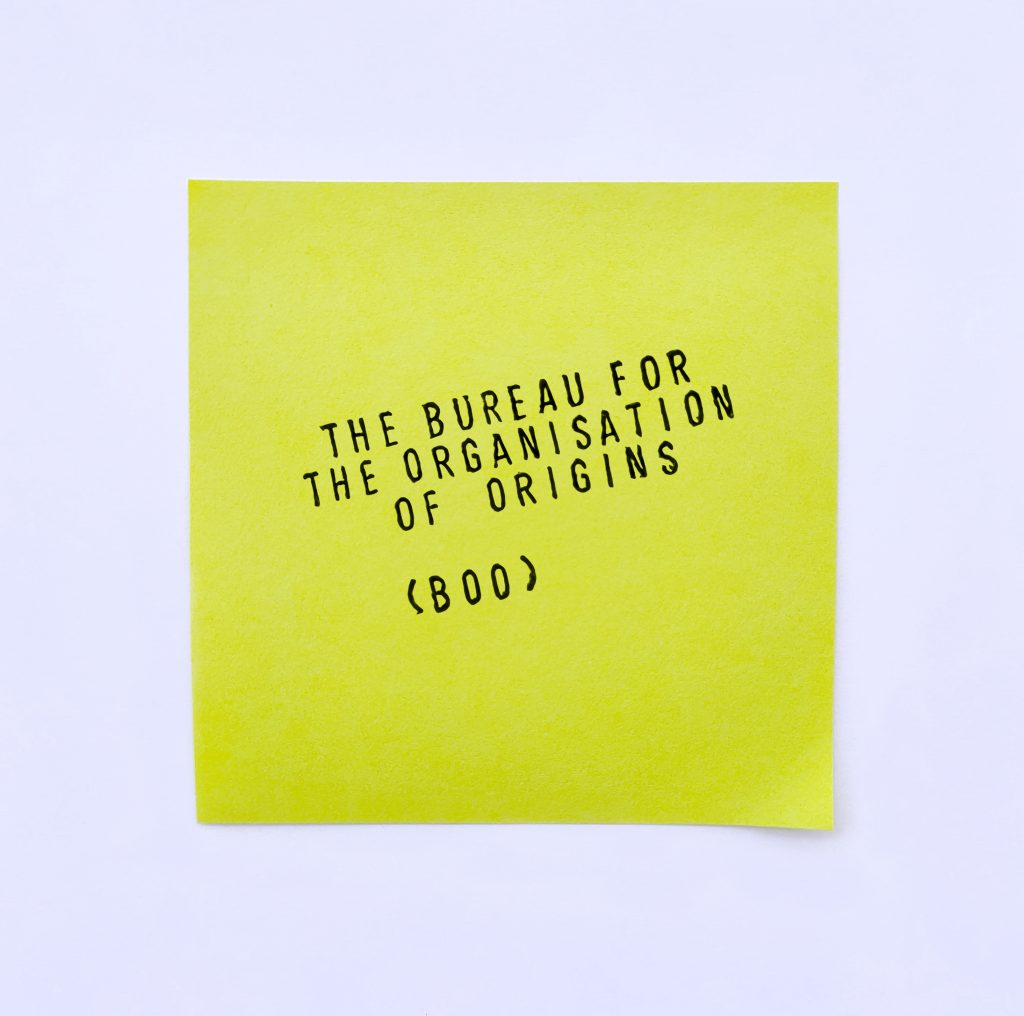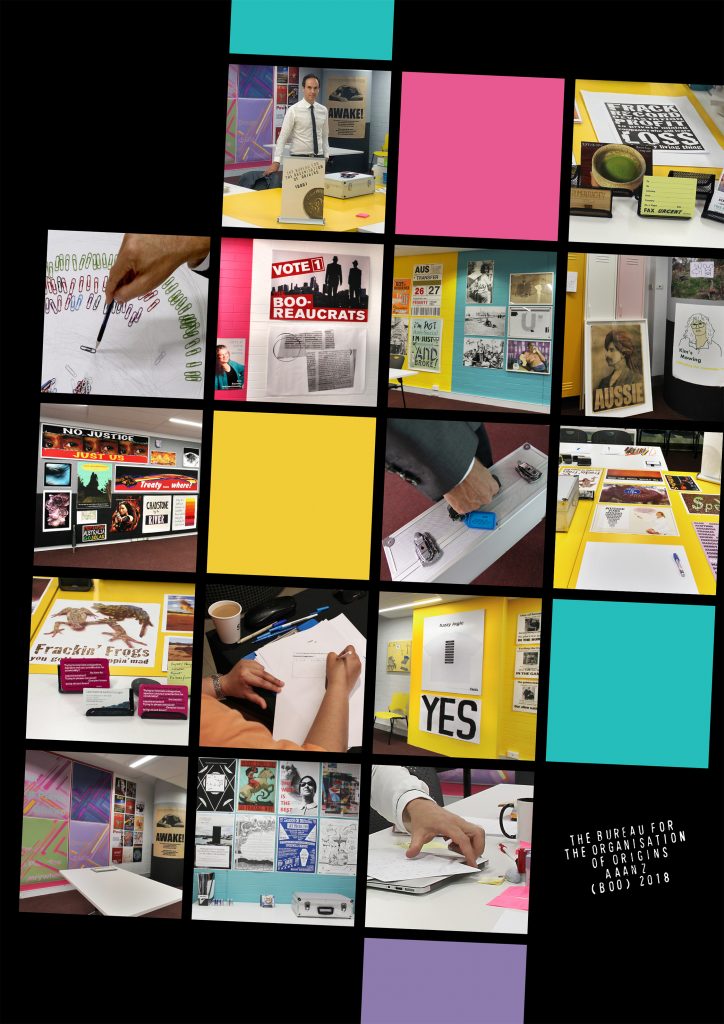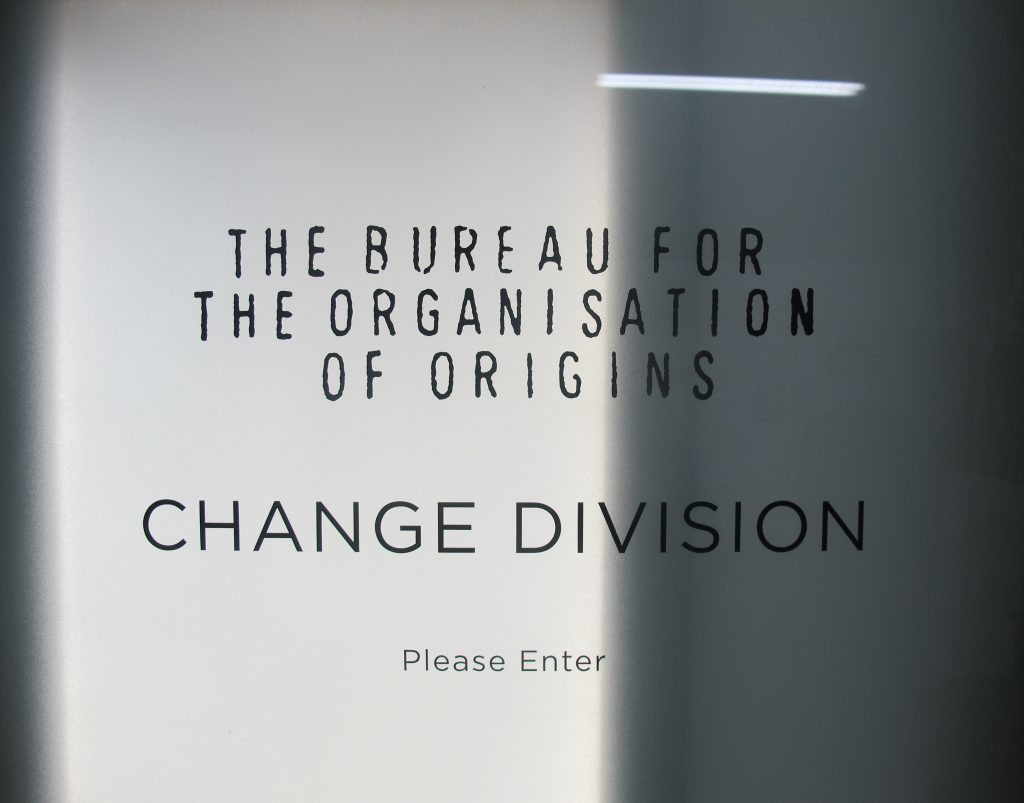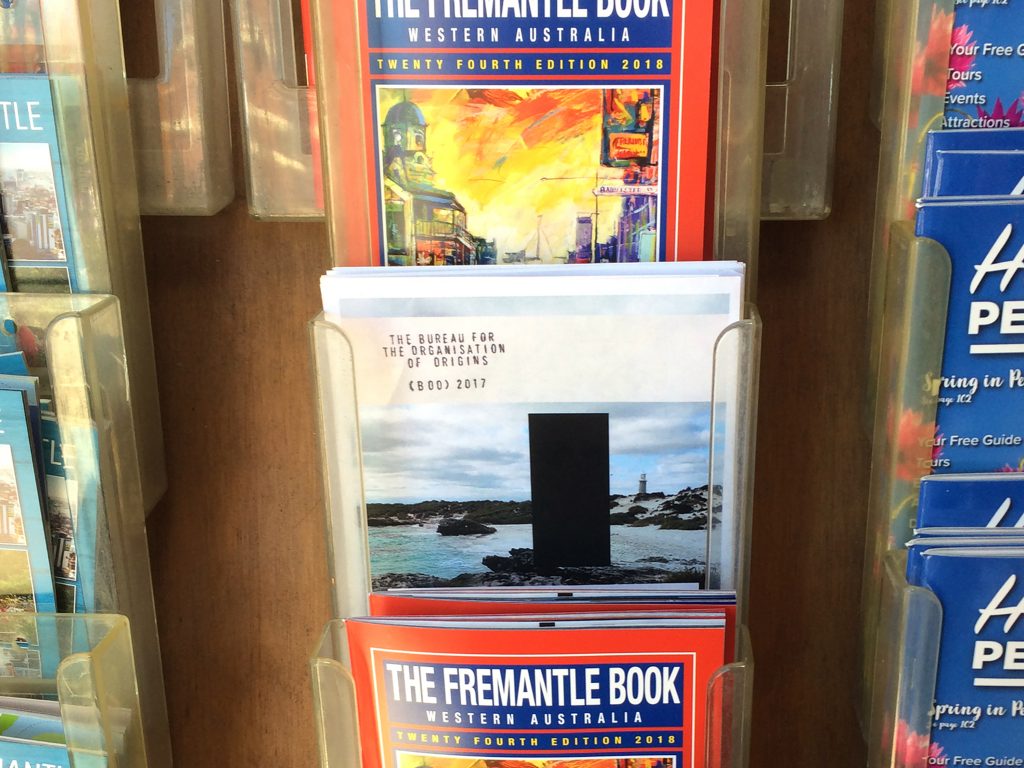
BOO Stamp, 2022.
Ink stamp on post-it note.
Image courtesy of The Bureau for the Organisation of Origins.
About The Bureau for the Organisation of Origins:
The Bureau for the Organisation of Origins (henceforth, The BOO) is a spurious administrative entity that organises creative expressions which examine, interrogate and reflect the complex reality of Australian national identity and attending notions of absolute cultural origin. With a growing network of participating contributors from across Australia and overseas, multiple gestures of visual art, performance and relational situations ask questions which are often taken for granted or assumed when considering received or inherited notions of national affiliation. The BOO works in the spirit of institutional bureaucracies, sometimes perplexingly, to highlight and examine nuanced issues of race, identity and ideology surrounding a contemporary nation state and associated implications within a global context.
Out of Office…
…being out of the office is complicated now. Many of us work online from dining tables and home studies. We carry computers in our pockets and can be on call 24/7. Are we ever really out of the office? (Faceless BOOreaucrat, 2021).
Out of Office… is a hybrid physical/virtual office space where The BOO will undertake its core business, investigating ideas surrounding the complex nature of national identity. In 2022, a vacant building in Melbourne will be activated as a collaborative space for The BOO to construct a new website and a hub for developing and presenting new content. The workspace provides a context for performative gestures and day-to-day tasks by BOO contributors drawn from expanded disciplines based in, but not exclusively, visual art. It provides an open platform for interactions with the public, including a series of performative and discursive events, exhibitions and the website launch.
Out of Office… serves as a developmental phase for an ongoing web presence for The BOO to publish past and future projects. It offers a virtual presence during rolling COVID-19 restrictions and maximises global audiences while highlighting, and capitalising on, the phenomenon of increased numbers of empty inner-city spaces.

Political Poster open call for AAANZ conference RMIT, 2018.
Artist page from Art & the Public Sphere, Volume 8, Number 2, 1 December 2019, pp. 183-186
Image courtesy of The Bureau for the Organisation of Origins.
Theoretical frames of reference and community of practice:
Invoking Horkheimer and Adorno’s conceptions of a totally administered world[1] and the frustratingly dystopian novels of Franz Kafka[2], Out of Office… draws on the ‘working’ model of an important precedent, The Office of Utopic Procedures (OUP)[3] at Westspace ARI in Melbourne. As a reflection and examination of the complexities of national identity expression, The BOO’s ongoing concern is manifold. Over time, shifting policies, immigration trends, and the evolution of cultural expressions means that singular perspectives with static representations are insufficient in reflecting the complexity of the whole. The open, working model adopted from OUP supports this.
More contemporaneously, a 2019 exhibition in New York titled Paperwork: Administrative Practice in Contemporary Art, staged at the International Studio & Curatorial Program[4] adopted aesthetics of bureaucracy to accentuate the structural underpinnings of culture. Participating artists dealt with issues of citizenship, colonialism and migration through music and bureaucratic language, such as Sandra Erbacher’s installation of ‘Eurodesks’ that celebrate and question the success and relevance of the European project in the context of Brexit and mass migration.
Using similar animating principles to these projects, The BOO adopts an approach of investigation, organisation and presentation. It extends the 1960s notion of an archival document as art object[5] by assuming the form of an ‘Organisation’ that encapsulates and presents complex expressions in relation to one another. Rather than take an ideological position, The BOO remains dispassionate. It does not aim to elevate one voice over another, rather it seeks to ask difficult questions and problematise received and under-examined ideologies.
Since its establishment over four years ago, The BOO has included more than 60 artists, activists, consultants and curators from Australia, South America, Europe, Scandinavia and the USA. With two major exhibited projects and other satellite gestures, it operates as an open and ongoing curatorial proposition; a new paradigm that extends thematically similar curatorial projects that manifest in one-off exhibition outcomes. The BOO is without disciplinary limitations—beyond the conceit of itself as an administrative entity supported by the mission statement that defines it.
The choice of a bureaucratic fiction operates analogous to ontological conceptions of nation state as an invented national structure that administers a multitude of sub-national interests. This bears relation to the complexity of the ‘Artworld’—a term that is often used to refer to all art making, makers and arts professionals without considering the multitude of intentions, functions, audiences and hierarchies (real and imagined) operating between all of the above.
As professor of American and Women’s Studies Toni Flores reminds us, we encounter the world in the form of rules and traditions, and possibilities for change, through our cultures of praxis[6] and the paradigm of a modern nation-state in this sense is the invisible structure that surrounds us all. The multifarious constitutive elements that operate under The BOO’s paradigmatic umbrella work in relation to each other and the bureaucratic context they are presented within.

Change Division detail 2020. Motion activated, backlit aluminium doorway with vinyl lettering and pot plant. Art for Social Change, The Incinerator Art Award, Moonee Ponds. Image courtesy of The Bureau for the Organisation of Origins.P
The BOO offers an alternative dialogue of contemplative deliberation while signalling the under-considered structures that have imperfectly provided a level of order for such discourse to flourish. Quite outside the specifics of content, the arrangement of creative responses in the conceit of a bureaucratic entity evokes such deliberative systems. The archival nature of The BOO furthers this attitude of interpretation. In referring to the modernist traditions of exhibition, art historian and academic Sven Spieker notes the function of the archive in revealing societal truths through the conditions of display.
Modernism promotes the idea of an archive that does not so much collect facts as reveal the conditions for their discovery, an archive whose peripheral objects become visible or audible to the extent that they conform to the archive’s own protocols.[7]
The BOO co-opts this thinking to extend an organisational paradigm that evolves traditional exhibition outcomes. Unlike popular and ideologically driven political projects, the notion of a single curator or creative author is replaced by a collectively conceived mission statement. This ensures that creative contributions and their relations are emphasised within the context of a deliberative structure that searches for greater understanding rather than contributing to polarising polemics.
The Bureau for the Organisation of Origins: Mission Statement
This mission statement for The Bureau for the Organisation of Origins was born in open collaboration between engaged participants following the 2017 inaugural exhibition. Devised to give a platform to all concerned, BOO projects are facilitated by an ethos constituted in the following:
1. The BOO is committed to listening and presenting a diversity of experiences, beliefs, opinions and arguments that examine, interrogate and speculate on, and around, aspects of national identity and notions of cultural origins.
2. As an organising structure, The BOO encourages individuated thematics, as reflected in section 1, that provide concision, facilitate sophisticated juxtapositions and maximise intelligent discourse.
3. The BOO promotes diversity and inclusion, rejects discrimination and upholds freedom of speech that does not facilitate hatred, discrimination or notions of racial supremacy.
4. a) Overall polemics are to be avoided.
4. b) Individual polemic gestures are tolerated, even advanced, when considered alongside multiple creative contributions, especially when balanced with opposing views.
5. The BOO does not equate listening to complicity or normalisation and recognises that there are often legitimate reasons for illegitimate beliefs.
6. Through the co-opted notion of a bureaucratic entity, the working nature of The BOO seeks to promote ongoing reappraisals of nationalistic expression and divisive rhetoric.
7. This mission statement is left perpetually open to revision given appropriate consensus amongst a significant body of contributing artists, writers and creatives.
Previous BOO projects:
2017 The Bureau for the Organisation of Origins (Inaugural Exhibition)
https://documentor.com.au/portfolio/bureau-organisation-origins/
Blindside Artist Run Initiative, Melbourne. 25 Jan-11 Feb.
Participants: Rushdi Anwar, Peter Burke and Adele Varcoe, Linda Choi, Dale Collier, Peter Drew, Jaye Early, Megan Evans, Carly Fischer, Raafat Ishak and Tom Nicholson, Sean Lowry, Mayatilli Marika, Wandjuk Marika OBE (c.1930-1987), Ramon Martinez-Mendoza, Performprint (Joel Gailer and Jenny Hall), Benjamin Sheppard, Nick Waddel, and Elmedin Žunić.
The Bureau for the Organisation of Origins was a multi-part exhibition that interrogated the problematic nature of representing Australian national identity through various artistic and performative gestures emanating from, and embodied within, the administrative model of a bureau.
As political attitudes shift towards the insular, notions of belonging to a nation state become increasingly problematic for various communities and demographic groups. In direct correspondence with the fervour surrounding ‘Australia Day’ in 2017, The BOO staged a series of participatory and collaborative gestures at Blindside Artist Run Space in Melbourne City and its immediate precinct. Through an extensive exhibition, The BOO began its speculation on the specific preoccupation with national identity by examining Australia’s cultural self-evaluation surrounding, and ‘celebrated’ on, Australia Day.
Comprising a ‘back room’ office and ‘waiting room’ foyer, Blindside’s two galleries were activated as working spaces for performances, sculptural installation, video and drawing practices, informal discussions with visiting groups and individuals and a recorded forum event. The juxtaposition of objects and actions worked to unpack the attitudes and actions that flood popular media platforms on Australia Day.
Historically important indigenous art by Yulngu artist, actor and activist Wandjuk Marika OBE (1927–1987) took centre place in the main gallery beside his framed OBE (signed by Queen Elizabeth II and Prince Phillip). This paradox of personal/tribal and colonial sovereignty stood next to contentious contemporary works: Carly Fischer’s monumentalised and deftly sculpted facsimiles of banal packaging and office materials; Sean Lowry’s formal co-option of an exhibition didactic convention to claim the entirety of Australia as a work—sampled by the view out of the 7th floor, south facing windows; Megan Evans’ erasure of familial colonial portraits with dried leaves found on country. Among these, Nick Waddel’s broken marble table, dressed with the aftermath of the opening event and punctuated with, what can only be taken as Tony Abbott’s ‘budgie smugglers’ stuffed into a wine glass, added an irreverent tone to the ostensibly austere front gallery space. Moving into the second space, the crisp facade of the Bureau gave way to the messy workings of the ‘back office’ with the pamphlet productions of Performprint Collective (Jenny Hall and Joel Gailer) and Benjamin Sheppard’s, studio practice; A seemingly pointless bureaucratic participatory work by Peter Burke and Adele Varcoe, culminated in an Australia shaped, office party pinata filled with real chocolate ‘Treaties’ provoking thought on what it really means to be Australian in a time that celebrates a day of dispossession.
2017 The BOO Forum
Blindside Artist Run Space, Melbourne. 2 Feb.
Facilitator: Benjamin Sheppard
Panel: Megan Evans, Raafat Ishak, Sean Lowry, Mayatilli Marika and Ramon Martinez-Mendoza.
A panel discussed the issue of a national day celebrated without consideration of the historical triggering of European dispossession. The most contentious aspect raised was the difficult question: Does calling Australia a ‘racist’ country help our shared aspirations? The complications being: racist compared to what (country) and whom? How can totalising language that flattens individual identity expression help combat that which does the same so problematically in reverse?
2017 The Bureau for the Organisation of Origins (Conference Presentation)
https://aaanz.info/wp-content/uploads/2017/12/2017-AAANZ-Program-Art-and-Its-Directions.pdf
Art and its Directions, Art Association of Australia and New Zealand Conference, The University of Western Australia, Perth. 6-8 Dec.
Presenter: BOO administrator, Benjamin Sheppard.
This conference presentation discussed the curatorial premise of The BOO project and the ramifications of the initial exhibition. It examined the potential of an ongoing discursive platform to interrogate the problematic nature of representing Australian national ideologies through various artistic and performative gestures emanating from, and embodied within, the administrative model of the ‘Bureau’.

Proposition to Reverse the Undetectable Redaction of an Unbuilt Monument, 2017. A5 flyer intervention in the tourist information office at Wadjemup (Rottnest Island). Image courtesy of The Bureau for the Organisation of Origins.
2017 Proposition to Reverse the Undetectable Redaction of an Unbuilt Monument (Fliers / Public intervention)
Wadjemup / Rottnest Island. 9 Dec.
BOO Administrators: Benjamin Sheppard & Peter Burke
This subsidiary collaboration between BOO administrators PB and BS saw the development of a public art gesture on Wadjemup (Rottnest Island) near Perth, Western Australia. A perplexing flyer offering a ‘Proposition to Reverse the Undetectable Redaction of an Unbuilt Monument’ was distributed via guerrilla tactics to tourists on the island.
2018 The BOOreaucrats – Wadjemup (Projection)
Hit Me With Your Best Shot, Biennale of Australian Art, Ballarat, Vic. Sept-Nov.
An image from the BOOreaucrats – Wadjemup Fieldwork series projected in the St Andrew’s Uniting Church grounds as part of BOAA’s expansive exhibition event. This image of two suited officials plays on received notions of respect given to ‘Officials’ as satirised in Gustave Flaubert’s definition in his posthumously published Dictionary of Received Ideas published in 1911-13.
2018 The Bureau for the Organisation of Origins (Political Poster open call) (Exhibition)
Aesthetics, Politics and Histories: The Social Context of Art, AAANZ Conference, RMIT University, Melbourne. 5-7 Dec.
Contributors: Ambulance, Grace Sophie Barelier, Franca Barraclough, BOOreaucrats – Peter Burke and Benjamin Sheppard, Nick Chilvers, Greg Creek, Desert Star Traders, Peter Drew, Oliver Eclipse, Alex Gibson, Catherine Gomersall, Ceri Hann, Brigid Hansen, Alison Hittmann, Raafat Ishak, Richard Harding, Dina Indrasafitri, Alex Kelly, Lucy Stewart-Kenneth, Jeffrey Kessel, Livia Kneubühler, Nico Liengme, Nico Liengme and Laurie May, Chips Mackinolty, Amanda Morgan, Wendy Murray, Esther Nunn, Performprint – Joel Gailer and Jenny Hall, Maz Prescott, Projekt Symbiosis, Public Field Office – Linda Roberts and Ceri Hann, Rumen Rachev, Elvis Richardson, Katie Sfetkidis, Dianne Stokes, Sonia Symantas, Bianca Tainsh, Masato Takasaka, Julie Jat Taylor, Nat Thomas, Nick Waddell, Ways and Means, Elmedin Zunić.
The BOO inhabited RMIT’s Creative Space during the AAANZ conference. Amongst over 70 political posters by 45 contributors, the workspace was staffed with The BOOreaucrats doing important (and not so important) ‘work’. This work facilitated the production and dissemination of bureaucratic pamphlets, publications, propaganda and other efforts of bureaucratic labour. Informal interviews were conducted with direct questions of origins which provoked sometimes difficult and often informative conversations.
2020 Change Division (Installation)
https://incineratorgallery.com.au/incinerator-art-award-exhibition/
Motion activated, backlit aluminium doorway with vinyl lettering and pot plant. 240 x 90 x 14 cm.
Exhibited within Art for Social Change, The Incinerator Art Award, Moonee Ponds. 28 Aug-1 Nov.
Some doors open. Others are locked. Some suggest activity occurring behind them while remaining obscured to the outsider. The Change Division of The Bureau for the Organisation of Origins has its lights on. It feels like things are happening, but are they? Is this a door that can be opened, or does it just feel that way? What do they do at the Change Division? A labelled doorway of frosted glass lit from within suggests an entrance into a division dedicated to change or perhaps one for changing our divisions. The sub-labelling reads ‘please enter’, but the door is locked.
2020 IAA2020 Symposium: GOVERNMENT
BOO administrators feature in this video as part of the 2020 Symposium Art for Social Change: Government, facilitated by curator Jake Traecy, The Incinerator Art Award, Moonee Ponds. 12 Sept.
Publications:
BOOklet
Editors: Benjamin Sheppard & Peter Burke
Held in Vancouver Library & Archive, Vancouver, Canada
and Franklin Furnace Artists’ Books Collection, Pratt Institute, Brooklyn. 18 pages. Edition: 50. 2017.
The Bureau for the Organisation of Origins
https://www.ingentaconnect.com/contentone/intellect/aps/2019/00000008/00000002/art00007
Authors: Benjamin Sheppard & Peter Burke, Art in the Public Sphere, Volume 8, Number 2, 1 December 2019, pp. 183-186(4).
The Bureau for the Organisation of Origins
thebureaufortheorganisationoforigins.com.au (website under construction)
[1] Max Horkheimer, Theodor W. Adorno. Translated by John Cumming. Dialectic of enlightenment. (New York: Continuum, 1972).
[2] Franz Kafka, The Trial (1925). Translated by Willa and Edwin Muir. (London: Vintage, 2005).
[3] Brett Jones, Bernhard Sachs, et al. The Office of Utopic Procedures. (Melbourne: West Space Inc., 2002).
https://westspace.org.au/exhi/6452/the-office-of-utopic-procedures
[4] “Paperwork: Administrative Practice in Contemporary Art” (June-August 2019), New York: International Studio & Curatorial Program. Curated by Kari Conte. Accessed 2/11/2021.
https://iscp-nyc.org/event/paperwork-administrative-practice-in-contemporary-art
[5] Christian Berger and Jessica Santone, “Documentation as Art Practice in the 1960s,” Visual Resources 32, no.3-4 (2016): 201-209. doi:10.1080/01973762.2016.1241030
[6] Toni Flores, “Art, Folklore, Bureaucracy and Ideology” Dialectical Anthropology, 10 (3/4) (1986): 252. Accessed on 5/11/2021.
https://www.jstor.org/stable/29790159
[7] Sven Spieker, The Big Archive: Art from Bureaucracy (London, UK Cambridge, USA: MIT Press 2019), 173.




